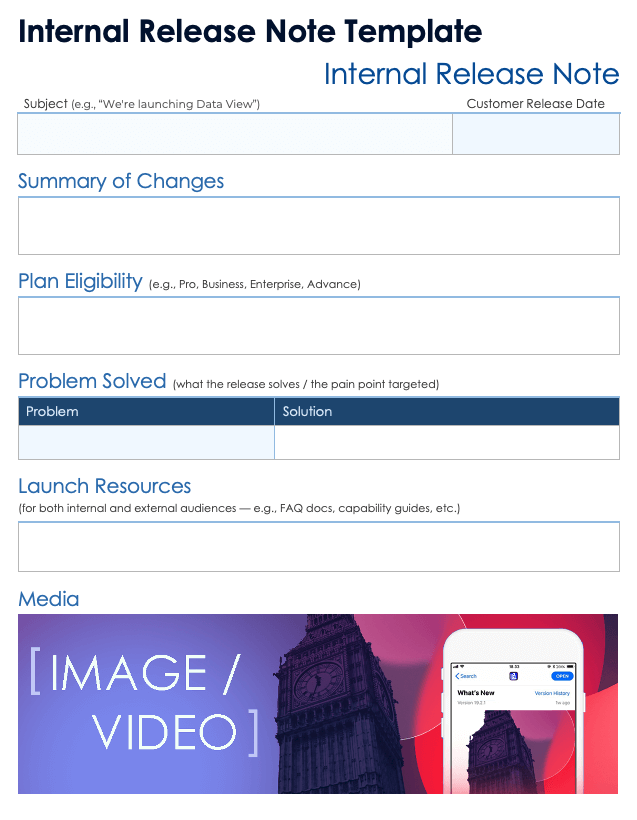Standard Major Release Note Template
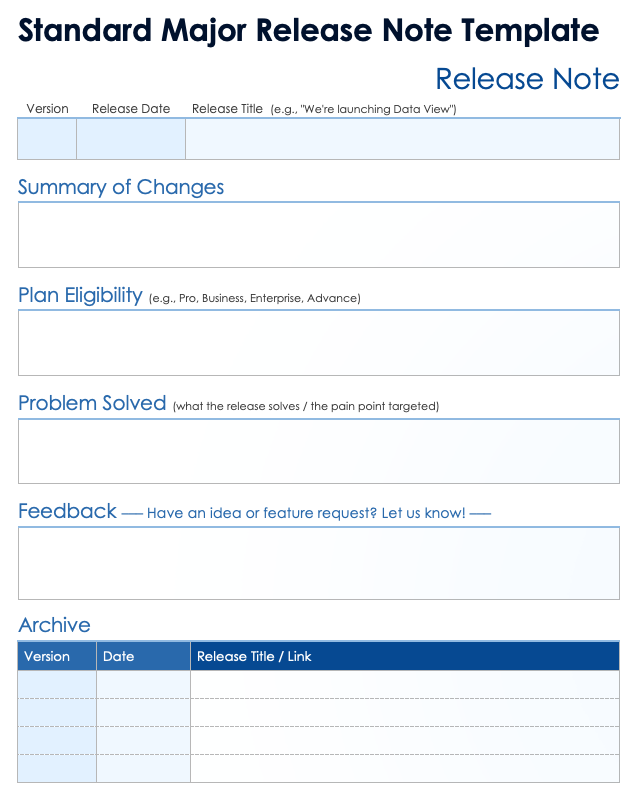
Download a Standard Major Release Note Template for
Microsoft Word
| Google Docs
When to Use This Template: Developers, marketers, QA teams, and technical writers can employ this template to share a general list of important updates with users. This includes new product versions, fixes, new and forthcoming features and improvements, and any other highlights that the audience needs to know.
Notable Template Features: This template includes room for images or videos that help illustrate important information, such as new features. It also invites audience engagement with a section for feedback or requests. You can adapt this template to fit various situations regardless of medium, product, or content — for example, you can focus on any individual area of the announcement (a new feature, update, or fix) as required, depending on the date or nature of the announcement.
Product Release Note Template
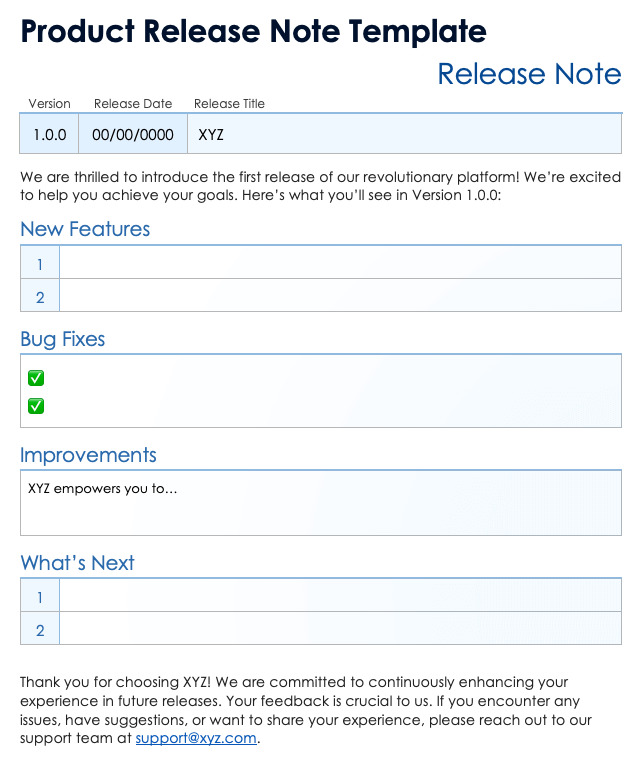
Download a Product Release Note Template for
Microsoft Word
| Google Docs
When to Use This Template: Use this template to communicate informally with your audience about changes to the product, while assuring them that your product is always improving and highlighting your brand’s personality. This template works well for summarizing any changes, updates, fixes, and new features to the end user without overwhelming them with technical information. Product release notes are typically published on a regular schedule, toward the end of the development cycle — essentially, when you have something significant to tell your users.
Notable Template Features: The categories, such as “fix,” “feature,” and “improvement,” allow you to classify the type of update for the audience. Product development lifecycles are becoming shorter to maintain relevance and keep up with customer needs. To reflect this, this template’s sections for highlighting the user impact and forthcoming features make it easy for readers to understand how these changes will affect their experience of the product.
Organize your product release process better with this pre-built product development roadmap template, and support your overall product management process with these free product management templates.
Technical Release Note Template
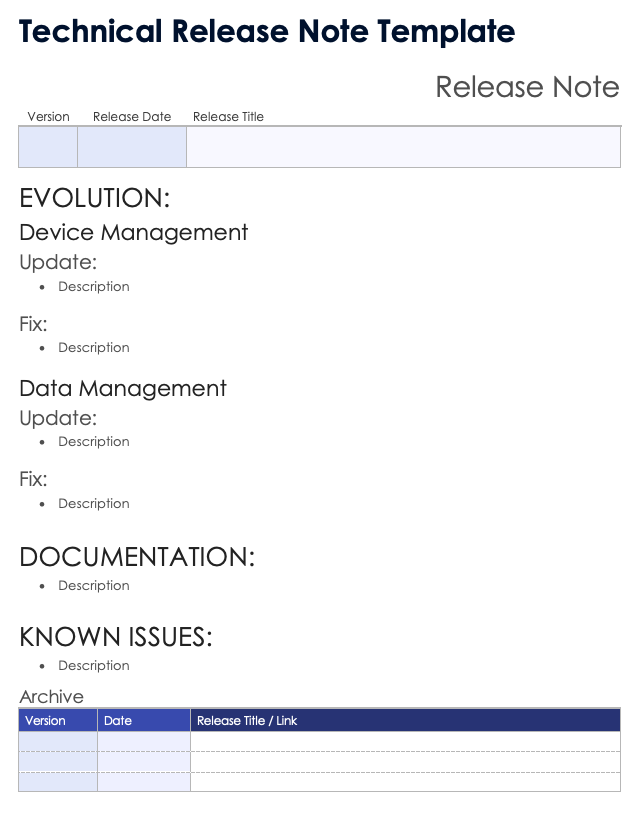
Download a Technical Release Note Template for
Microsoft Word
| Google Docs
When to Use This Template: Use this template when you need to communicate in-depth technical details, such as configuration changes, system requirements, dependency updates, implementation details, algorithms, or architectural changes. Technical release notes detail any code changes, bug fixes, and technical implementations that internal teams and other coders need to know, but the average end user doesn’t. Technical release notes are especially important for developer tools, APIs, or anything that requires integration into other systems.
Notable Template Features: This template offers room to expand on technical details throughout the version history of the software. You can also provide detailed technical instructions, troubleshooting tips, and impact assessments about each version.
Microsoft Word Software Release Note Template
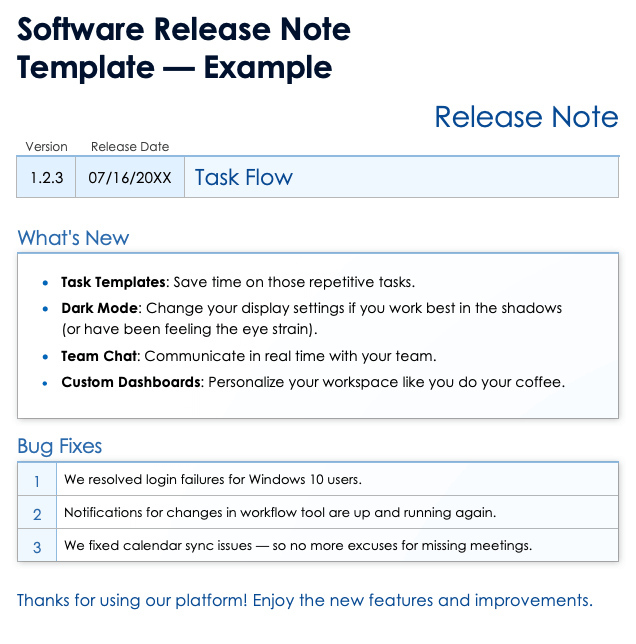
Download the Blank Software Release Note Template for Microsoft Word
Download the Software Release Note Template with Sample Copy for Microsoft Word
When to Use This Template: Use this template to summarize information in the technical release note in terms that the average end user can understand. When people use the term “release notes,” they typically mean software release notes, which are a subset of overall product release notes that often overlap with more generic product release notes, especially for SaaS products. However, this template offers more space for technical information while remaining clear and accessible, and is more suited to end users than are technical release notes.
Notable Template Features: Available with or without sample data, this template highlights the date and version number of the release, drawing the user’s attention to a list of important points that are organized around these two headings. This template is simple and minimal, and it conveys only what the user needs to know about every release, such as news — including updates, improvements, or new features — and fixes.
Optimize your software version release process with this guide to release management.
Microsoft Word App Store Release Note Template
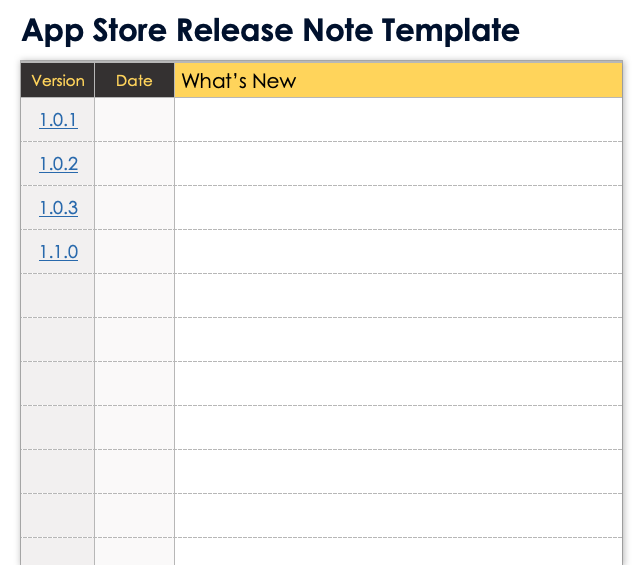
Download the App Store Release Note Template for Microsoft Word
When to Use This Template: This template is best for grabbing the audience’s attention and earning loyalty with a simple presentation, while also informing them of the most important updates. These release notes are delivered to the customer through the app store, rather than posted on the product website, so they must be short and concise.
Notable Template Features: This template consists mainly of the version number and date followed by the What’s New section. This draws the user’s attention to the most important changes to the product. The sentences should be short and easy to read.
Microsoft Word Hotfix Release Note Template
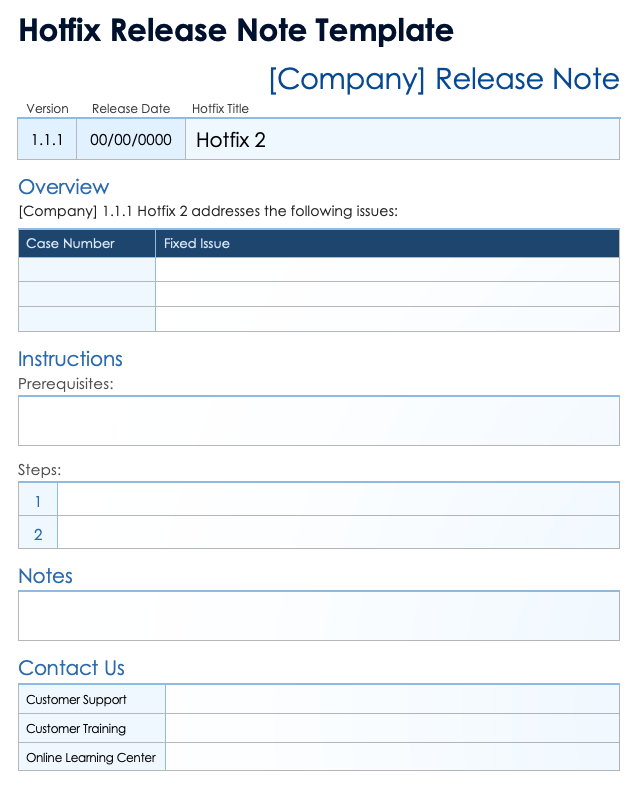
Download the Hotfix Release Note Template for Microsoft Word
When to Use This Template: Use this template to relay urgent problems with the product, along with the corresponding solutions or fixes (not longer-term updates or new features). This template is particularly relevant when you need to communicate with the customer outside of the regular software release cycle.
Notable Template Features: This template offers sections to present a summary of the urgent changes to the product, followed by a list of fixes. It also includes a section to instruct users on how to install the hotfix or update their systems to incorporate it, ensuring that their experience of the product is always smooth and up-to-date. The contact information also encourages engagement or directs them to customer support.
Microsoft Word Patch Release Note Template
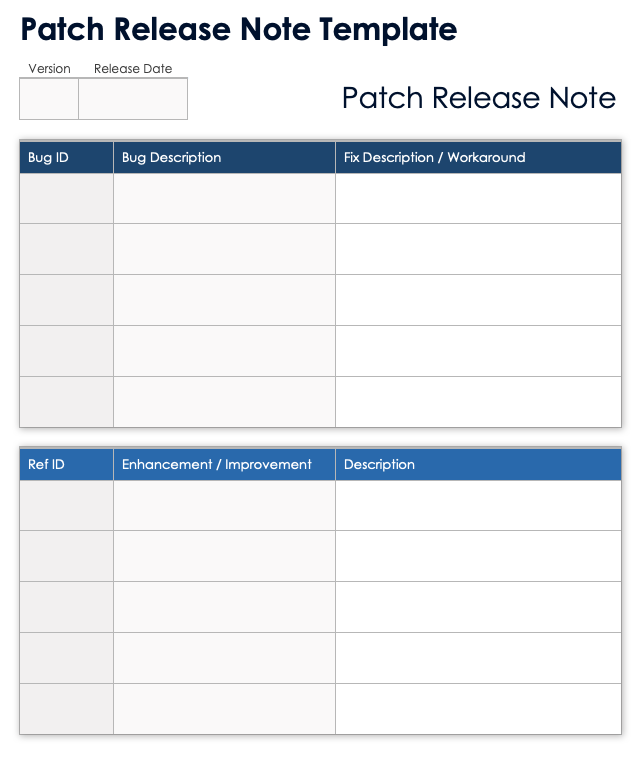
Download the Patch Release Note Template for Microsoft Word
When to Use This Template: Use this template to inform customers about minor improvements and bug fixes, rather than any major changes or updates. With this template, you can provide tips and instructions on how to avoid known issues, but not overwhelm the user with detailed technical information.
Notable Template Features: This template includes a column to identify every bug and enhancement with a reference number, which makes it easy to ensure that improvements are tracked. It also includes columns for detailing the exact bug description and the corresponding fix or workaround, as well as particular enhancements or quality-of-life improvements.
Common Elements in Release Notes
Release notes are published documents that provide users with necessary updates about a product or software. These notes can describe new features, bug fixes, quality-of-life improvements, enhancements, ongoing issues, new solutions, and more.
Release notes are an important way for the development, product, or QA teams to communicate with end users, customers, and stakeholders to keep them apprised of new developments. These documents also help users understand what to expect and can be used to collect feedback and questions.
Here are some common features of release notes:
- Product Name, Version Information, and Release Date: These three features identify the product and the particular update and release.
- Summary: This section can provide users with a brief overview of major changes to the product before launching into more detail.
- New Features: This section typically lists and describes any new features in the product.
- Improvements: This section lists and describes updates and enhancements to old features of the product.
- Bug Fixes: This is generally the most common and urgent section of a release note. It lists and describes issues or problems with the product that have been resolved in the latest version.
- Ongoing Issues: In this section, acknowledge any other known problems or limitations with the product that you are still actively investigating and that may be resolved by the next release.
- Installation Notes: In this section, explain what the user needs to do if the new release of the product requires users to conduct an installation or upgrade.
- Security Notes: In this section, update the user on any security-related changes to the product.
- Feedback: This is an important section where you can thank the user for their continued support and encourage them to reach out with any questions or concerns about the product. Your team can internalize any feedback and continue to work to provide the best experience.
Types of Release Notes
The different types of release notes include product release notes, technical or software release notes, major and minor release notes, announcements, updates, fixes, improvements, internal release notes, and end user release notes. There are also different ways to organize them.
According to Freddie Harrison, who leads Product Marketing at Sketch, you can use an “inverted pyramid” to classify release notes: At the top, he says, “You’ve got notes that answer the question, ‘What’s new?’” Each level of release notes answers a different question, and a comprehensive release note, Harrison says, is likely to answer all of them.
- What’s New? “These are for big, flashy new features you want your customers to be excited about — the headliners,” says Harrison.
- What’s Improved? These release notes communicate improvements, which may or may not be new.
- What’s Changed? “We’re into natural territory now,” Harrison says. “Changes don’t have to be good or bad, although you’d hope they lean toward good. But they are changes your customer should be aware of because, one way or another, they’re going to impact their workflow.”
- What’s Fixed? These release notes describe patches, hotfixes, and other minor solutions.
There are a few key factors that determine the type and organization of a release note: the scale of the release, the content of the release, and the audience. See more specifics below:
- Scale of Release: Release notes can be distinguished based on the urgency of the information being communicated. You can differentiate between major and minor release notes.
- Major Release Notes: These can use a variety of formats or delivery methods, but they all communicate significant, long-term changes to the product, such as major overhauls or upcoming new features. One example would be the complete redesign of a product’s mobile app and its user interface, or the addition of a new core feature such as direct messaging.
- Minor Release Notes: These release notes also communicate new features, but these features don’t fundamentally change the product — such as new colors or filters, or faster loading times.
- Content of Release: Release notes can also be distinguished based on which kind of information they prefer to focus on, such as features and updates, patches or bug fixes, improvements, or deprecations:
- Features and Updates: These notes communicate information about new features or updates.
- Patches or Bug Fixes: These update the user about issues that have been resolved or vulnerabilities that have been addressed, as well as workarounds and other recommended actions.
- Improvements: These release notes generally address performance improvements, such as faster loading time or reduced battery usage.
- Deprecations: Deprecation release notes inform users of features that are being phased out.
- Audience: The intended audience will also affect how you write and organize your release note:
- End User Release Notes: These can be product release notes, software release notes, app store release notes, or patch and hotfix release notes. In each case, the main stakeholder is the end user.
- Internal Release Notes: These are targeted at internal stakeholders, such as developers, quality assurance teams, product managers, or technical writers. They often include technical information or instructions for installing and testing a new release. Internal release notes might also include beta release notes, which are circulated during the testing phase of a new release. Beta release notes provide information about known issues or features being tested to the teams conducting tests.
How to Write Release Notes
Release notes are usually simple and straightforward. Often they are dry and technical, but they can also be entertaining. Most notes should generally try and find a middle ground between silly and boring.
Follow the below general steps to write a release note:
1. Research Your Subject Matter
Make sure that you have a solid understanding of the product you’re about to write about. To gain this knowledge, you may consult experts, such as the development or product team. However, remember to think like your readers, who often don’t have technical expertise.
“The details matter,” says Harrison. “Ask developers, designers, and your product team questions if you’re not clear on the change you’re about to explain.” At the same time, he says, it’s important to “take a step back and remember that (in most cases at least), your developers are not your customers.” Understanding your audience is just as important as understanding your subject matter.
2. Write the Release Note
Once you have a solid understanding of both the subject and the audience, start writing. Avoid jargon and keep your language clear and message succinct. “It’s easy to get hung up on specific details that few customers are ever likely to encounter. In doing so, you end up writing something verbose or difficult to understand,” says Harrison. “You’ve got an incredibly finite attention span to deal with. Give people a reason to want to read what you’ve written, reward them for their attention with a quick joke, but at the same time, get your point across quickly. Don’t waste a word.”
3. Publish the Release Note on the Appropriate Channel(s)
Once you’re done writing, organize your release notes and identify which distribution channel is most appropriate for them. “Give them a logical hierarchy. Identify your heroes of the release,” says Harrison.
“If you’ve got a big, brand-new feature to talk about that you know your customers will love, it makes sense to go big,” he says. “You’re going to roll those ‘What’s new?’ notes out across every channel — in-app, social, email, and elsewhere. The message is going to stay consistent, but you might add more detail, including images or video content, to help get your point across, in certain places.”
For smaller releases such as bug fixes or incremental updates, he says, “a low-key approach might be more appropriate. Maybe you’ll rely solely on email or your in-app method of delivery.”
Streamline and Refine Your Release Notes with Real-Time Work Management in Smartsheet
Empower your people to go above and beyond with a flexible platform designed to match the needs of your team — and adapt as those needs change.
The Smartsheet platform makes it easy to plan, capture, manage, and report on work from anywhere, helping your team be more effective and get more done. Report on key metrics and get real-time visibility into work as it happens with roll-up reports, dashboards, and automated workflows built to keep your team connected and informed.
When teams have clarity into the work getting done, there’s no telling how much more they can accomplish in the same amount of time. Try Smartsheet for free, today.
